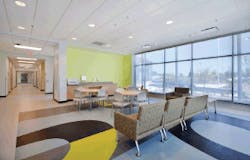St. Louis Community College Opens LEED Gold-Designed Facility
Many of today’s college students expect the schools they attend to not only offer them a variety of courses along with access to the latest technologies, but also to practice and promote environmental stewardship. A recently opened St. Louis Community College (STLCC) satellite facility fulfills all of these requirements and more.
Located on a series of formerly vacant lots in an inner-city residential neighborhood in north central St. Louis, the $7.5-million William J. Harrison Education Center is a LEED-registered project designed with the goal of attaining Gold Certification.
“The building was purposely situated within sight of a public high school to try and provide more visibility to higher education,” explains Greg Bridenbaugh, electrical department manager for St. Louis-based KAI Design & Build, the company responsible for the center’s architectural, MEP, and fire protection design.
Able to accommodate 400 to 500 credit students and 4,500 continuing education students, the two-story, 29,700-sq-ft facility offers classes and programs in a range of areas, including environmental worker training, art, general science, small business entrepreneurship, automated office skills, health care, and culinary arts. Spaces include an art studio, general science lab, a multi-purpose community room, computer labs, classrooms, a bookstore, commons area, an outreach center, and administrative offices.
To help achieve LEED Gold certification, KAI researched and specified products as well as technology that would earn the largest number of LEED points possible for the various categories, including the electrical systems.
“With LEED Gold as our goal, the budget was extremely tight,” says Bridenbaugh. “We met that challenge by supplying regular lighting products for the majority of the spaces as opposed to high-end lighting products.”
According to Bridenbaugh, the dominant fixture used throughout the center is a direct/indirect recessed luminaire. Typical lamps are standard T8 32W fluorescents while ballasts are high-power factor electronic with less than 10% total harmonic distortion.
“We did use some CFLs, but those feature an electronic ballast with triple tube design,” he adds. “LED fixtures were limited to exit lights, certain in-ground exterior fixtures, and some casework illumination.”
To further reduce the building’s energy usage, KAI equipped most large spaces with ceiling-mounted dual-technology type occupancy sensors. In smaller spaces, such as private offices and janitor closets, wall switch line voltage dual-technology units were specified.
“We used dual-technology sensors to avoid the issues associated with the older technology,” says Bridenbaugh. “For example, the lights did not come on when they should and turned off when they shouldn’t. These types of sensors eliminate those complaints.”
Other energy-saving electrical features include low-voltage relay panels for master control of the interior lighting and a power distribution system designed to include panelboards dedicated to serving only lighting and HVAC loads. Submeters installed on these panels monitor the amount of energy consumed only by lighting and HVAC loads.
The facility also includes a glass elevator tower and a large central atrium that provides natural daylighting. Furthermore, all student classrooms and faculty offices are located off a single central corridor, allowing the spaces to incorporate windows because they are located along an exterior wall.
After 18 months, the Harrison Education Center opened on schedule last August to welcome its first students.
About the Author
Stefanie Kure
Content Producer - EC&M
Stefanie Kure is the senior associate editor of EC&M magazine. She holds a Bachelor of Arts degree from the University of Kansas and has more than 20 years of experience in the B2B magazine industry. In addition to EC&M, Stefanie has worked on Transmission & Distribution World magazine, Broadcast Engineering magazine, and Power Electronics Technology magazine.
